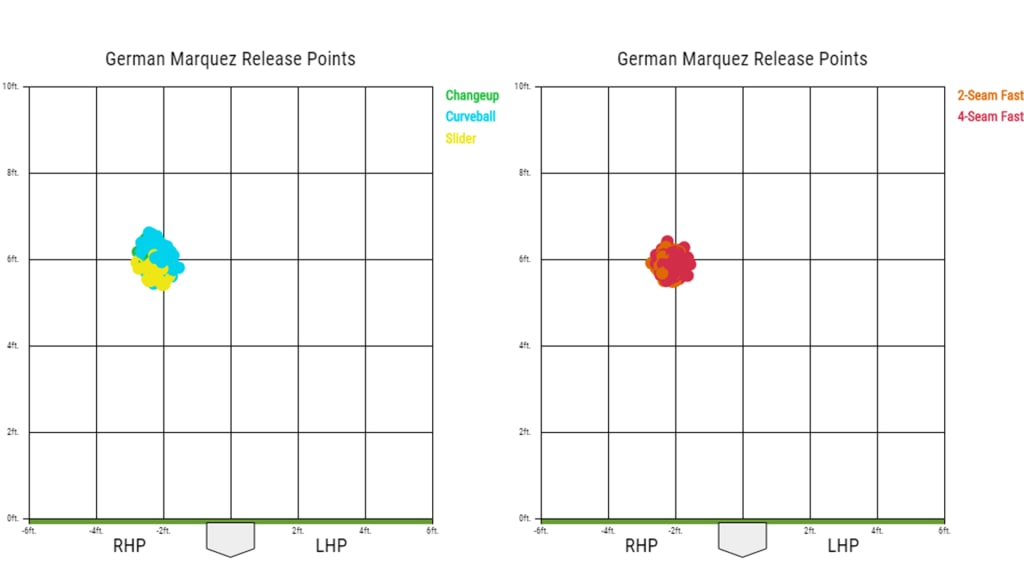
DENVER -- Hand speed was the topic of conversation on a warm morning at the Rockies' Spring Training facility last year. Bullpen coach Darren Holmes, a respected specialist at identifying the skill, was talking, while pitching coach Steve Foster listened intently.
The subject: German Marquez, the flamethrowing Rockies right-hander who the club had acquired one year prior in a trade that sent Corey Dickerson to the Rays, and who entered camp battling for a rotation spot.
"I think this guy needs a slider," Holmes said, but putting it on the backburner while Marquez continued to hone the location woes he possessed on his fastball, which touched triple digits velocity.
It's been a year and a half since that powwow, but it's remembered vividly among Colorado's pitching braintrust as the genesis for what has propelled Marquez into the spotlight in the thick of the National League pennant chase. Over his 10 outings since the All-Star break, the Rockies are 7-3 and Marquez has a 2.63 ERA and a whopping 89 strikeouts, a mark that trails only Max Scherzer (95), Carlos Carrasco (94) and Jacob deGrom (89) for the MLB high in that span.
The root of the uptick in punchouts has been the foritifcation of his five-pitch repertoire -- the slider, two-seam and four-seam fastballs, which average 95.1 mph, a 12-6 curveball and a servicable changeup -- with premium on his breaking pitches. Last year, Marquez was essentially working with his four-seamer and curve.
*Most strikeouts on breaking pitches since the All-Star break
1. German Marquez: 71**
2. Patrick Corbin: 69
3. Carlos Carrasco: 62
4. Clayton Kershaw: 49
5. Justin Verlander: 46
*Breaking: Sliders, curveballs, knuckleballs
Fastball command dictates Marquez's approach, and his slider has worked masterfully off of it, giving him another weapon on days when he doesn't have his best stuff or when he's giving hitters different looks the second or third time through the lineup. But batters are hitting .319 with nine homers off his fastball this year, which has prompted him to turn to the slider more.
"It's become really good and it's getting better every time," Marquez said. "Between my curveball and my slider, I've got a lot of confidence. I can throw it for a strike or strike them out. So I've got a lot of confidence."
In the second half, Marquez has thrown breaking balls 43.6 percent of the time, up from 35.3 percent, and he's seen remarkable success. Never was that more glaring than in his Aug. 31 win at San Diego, when he struck out a career-high 13, including 12 on breaking pitches -- tied for the most by any pitcher in any game this year.
There have been other gems, too, and against contenders and in the midst of the Rockies late-summer surge, such as a road win over Justin Verlander, a critical road victory as part of a four-game sweep in Atlanta and a seven-shutout-inning masterpiece against the Cardinals.
Take away a rough first start out of the break at Arizona, and batters are hitting just .102 and slugging .195 against his breaking balls, which are the fourth- and sixth-lowest marks among 58 pitchers who've had at least 50 at-bats decided on such offerings in that stretch. And he's going to them in the majority of his two-strike counts, which questions why he wasn't doing so sooner. Put simply: mechanics and location.
Marquez struggled early in the year with tempo by not creating enough variation in his delivery between his fastball and secondary offerings, which made his pitches easier to identify out of hand, Foster said. Marquez has done a better job "staying behind the baseball" by not putting his fingers around the ball on delivery, which helps the ball avoid unintended cut, stay true and have carry through the zone. Perhaps as such, Marquez's strikeout-to-walk ratio from the first half to second has gone from 15.3 to 27.1 percent.
"The command is starting to improve," Rockies manager Bud Black said. "The walks are down from the first half of the year. His ability to locate the breaking ball is better. He's grown. He's maturing. He's getting better."
By shoring up his mechanics and creating a more uniform release point across his repertoire, Marquez has better disguised his secondary pitches. On a good day, the velocity variation -- Marquez has touched 100 mph and dropped to the mid-70s on his curve -- from a similar arm slot can leave hitters guessing.

"It's really hard to hit because there's a bunch of separation between speeds," said Tony Wolters, Marquez's primary catcher. "If he has a really good curveball that day, I'm going to throw his curveball a lot because it makes his fastball look 110 [mph]. If his slider is good, I'm going to mix in his slider, because it's really hard to hit. He keeps it down in the zone. It just depends on what he has."
In 2017, Marquez led all rookies with 147 strikeouts, and he's already at 195 this season, trailing only the NL Cy Young Award favorites (deGrom, Scherzer and Aaron Nola) and Corbin in the NL. Logic and history suggests that hitters will adjust to Marquez's polished approach, but the Rockies believe that Marquez possesses an acumen and coachable enough attitude to adjust back.
It's been a driving force in their late-summer swing into first place. And it will likely be a vital source for their survival should they reach October.
